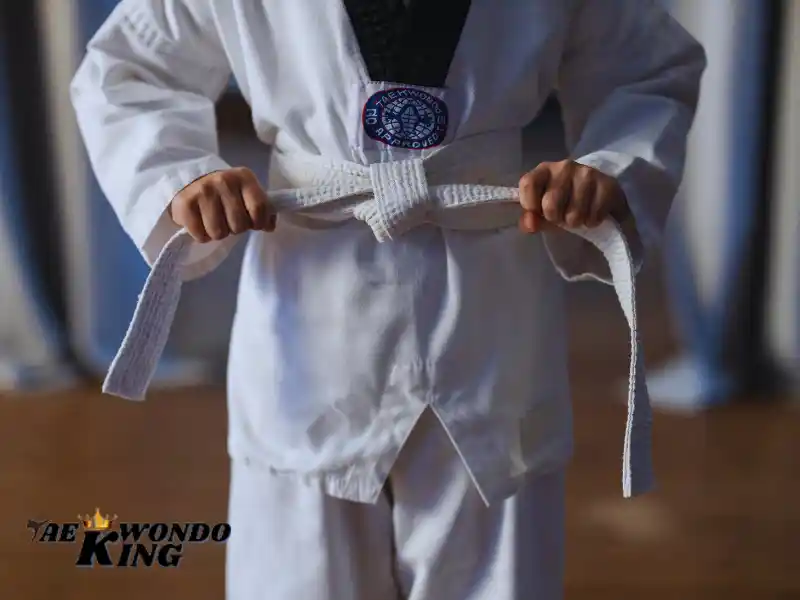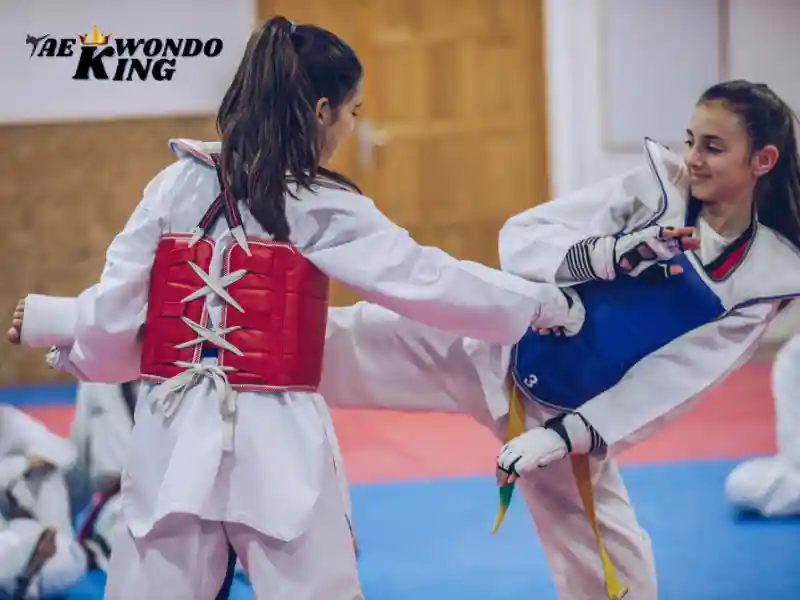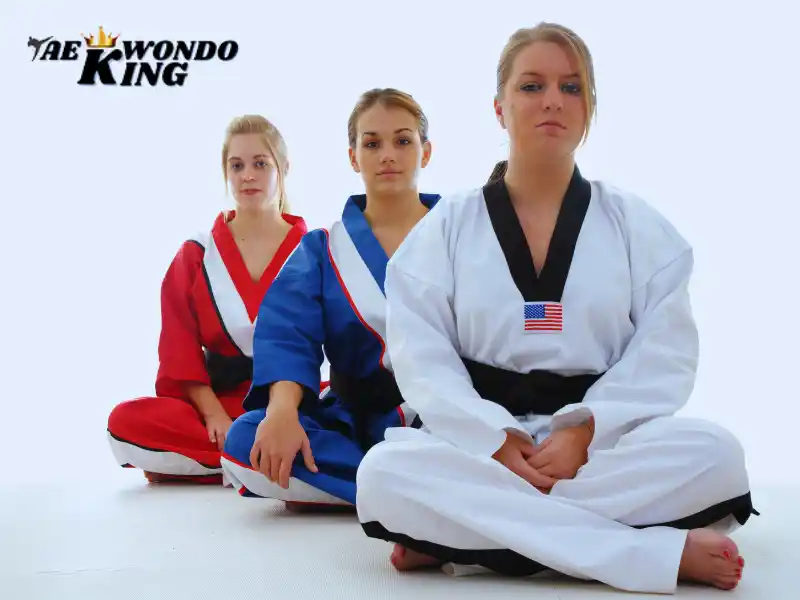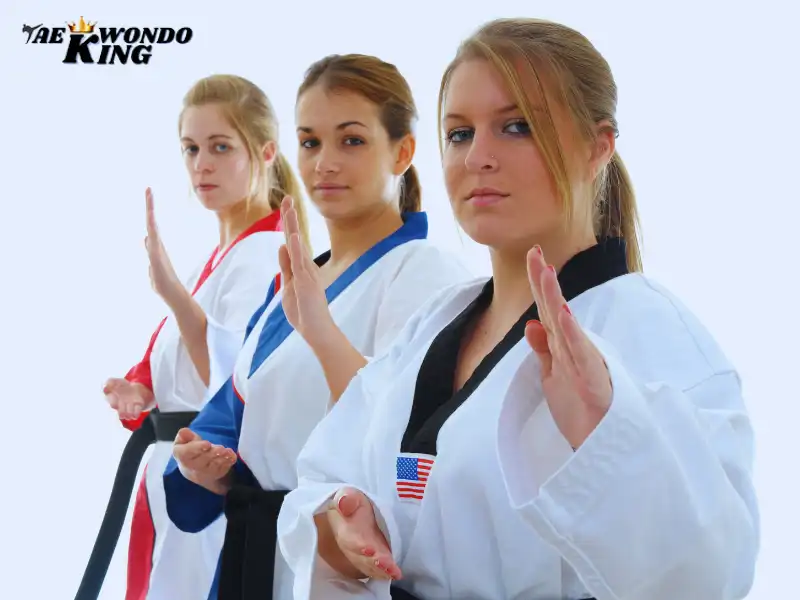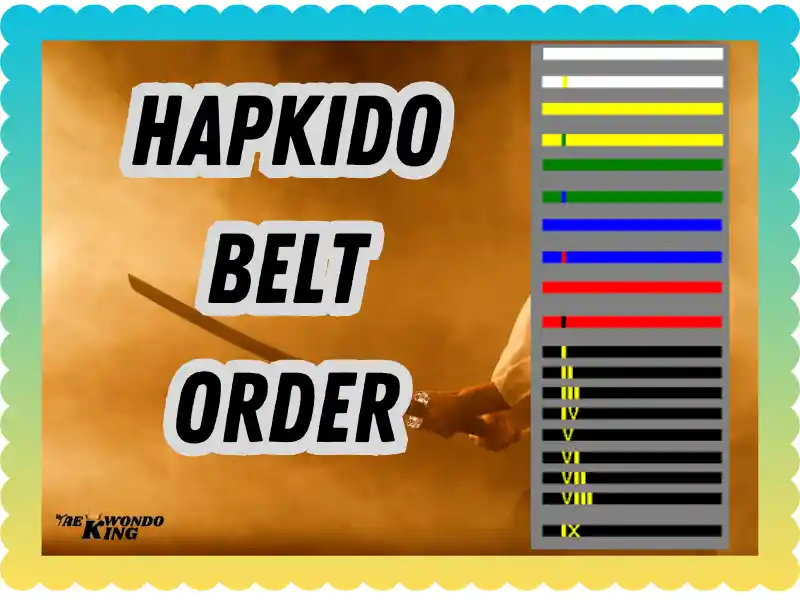
I first started Hapkido, and understanding the Hapkido belt order felt like unlocking a secret code. Each belt represented more than just a color change; it signified my growth and progression in mastering the art. The belt order isn’t just about how far you’ve come. But also about the skills and discipline you’ve developed along the way.
Get updates by joining Taekwondoking’s official WhatsApp channel.
In this guide, I’ll walk you through the Hapkido belt order, how each level builds on the last, and what it takes to move forward. Let’s dive in!
Start Your Hapkido Journey Today!
What Is the Hapkido Belt Order?

The hapkido belt order follows a structured path. Students start as beginners and work their way up. Each belt has its requirements. With time and training, students advance through the ranks.
Hapkido Belt System
The Hapkido belt system is designed to reflect your progression as a martial artist, with each belt representing a new level of mastery. I remember the pride I felt when I moved from one belt to the next, realizing that each step involved not just learning techniques but also embracing the philosophy of Hapkido. It’s a journey of growth, both physically and mentally.
What Does It Mean When You Get a Hapkido Black Belt?
Earning a Hapkido black belt is a huge milestone, marking years of dedication, hard work, and perseverance. I earned my black belt, it felt like I had just unlocked a new chapter in my journey, filled with responsibility and a deeper understanding of the art. It’s not just about the color, it’s about mastery of technique, discipline, and the ability to teach others.
- Black Belt (Advanced)
- 1st Dan Black Belt
- 2nd Dan Black Belt
- 3rd Dan Black Belt
- 4th Dan Black Belt
- 5th Dan Black Belt
- 6th Dan Black Belt
- 7th Dan Black Belt
- 8th Dan Black Belt
- 9th Dan Black Belt

Hapkido Belt Ranks in Order
Understanding the Hapkido belt ranks in order is key to knowing how your progression will unfold. From the beginner white belt to the esteemed black belt, each rank brings new challenges and responsibilities. I remember starting at white belt, thinking it would take forever to reach black belt, but with consistent effort, each rank built on what I had learned before. In this section, I’ll outline the belt ranks so you can understand where you’re heading on your journey.
- White Belt (Beginner)
- Yellow Belt (Beginner)
- Green Belt (Intermediate)
- Blue Belt (Intermediate)
- Red Belt (Advanced)
- Red/Black Belt (Advanced)
- Black Belt (Advanced)
- 1st Dan Black Belt
- 2nd Dan Black Belt
- 3rd Dan Black Belt
- 4th Dan Black Belt
- 5th Dan Black Belt
- 6th Dan Black Belt
- 7th Dan Black Belt
- 8th Dan Black Belt
- 9th Dan Black Belt
Why Does Hapkido Use a Belt System?
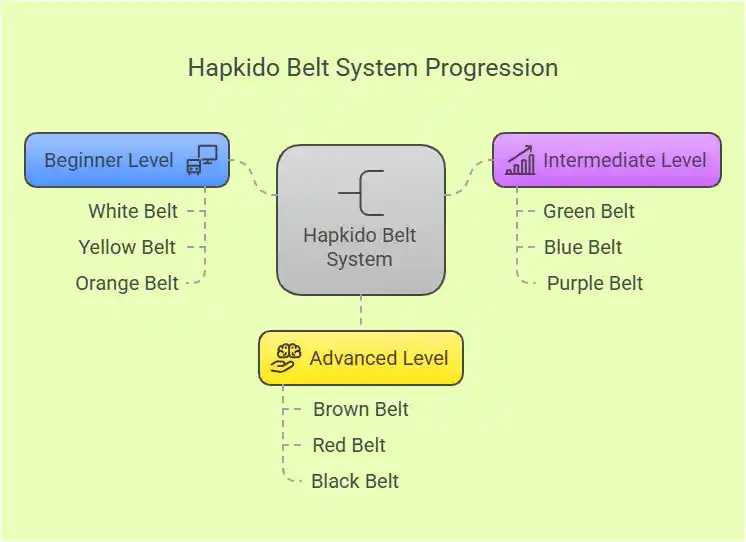
The belt system helps track progress. It gives students goals to reach. Each belt teaches new techniques. The hapkido belt order also shows respect for tradition.
The Beginner Level Belts
Students start with basic belts. Find Out What Each Belt Means! These colors show a beginner’s progress.
White Belt
The white belt is the first belt. It represents a blank slate. Students learn basic movements and stances. They also practice discipline and respect.
Yellow Belt
The yellow belt is the next step. It symbolizes the first rays of knowledge. Students learn simple strikes and blocks. They also practice basic joint locks.
Orange Belt
At the orange belt level, students improve control. They learn new kicks and escapes. The hapkido belt order begins to test endurance.
The Intermediate Level Belts
Students at this level gain more skills. Find Out What Each Belt Means! They also learn more complex techniques.
Green Belt
Green represents growth. Students refine their strikes and kicks. They also learn advanced blocks. Hapkido begins to feel more natural at this stage.
Blue Belt
Blue symbolizes depth. Students explore deeper techniques. They improve their throws and falls. Strength and control become key at this level.
Purple Belt
The purple belt shows a higher level of skill. Students learn to combine movements. Timing and balance are tested. The hapkido belt order requires patience here.
The Advanced Level Belts
Advanced belts require strong discipline. How Long to Get a Black Belt? Learn More! Students show control, precision, and focus.
Brown Belt
Brown represents maturity. Students master their techniques. They also begin sparring with more resistance. Strength and endurance improve.
Red Belt
Red signifies danger and power. Students learn high-level skills. Their control must be perfect. The hapkido belt order starts to prepare students for mastery.
Black Belt
The black belt has the highest rank among many systems. It represents mastery and deep understanding. Students must show complete control. They also begin teaching others. Master Hapkido – One Belt at a Time!
Degrees of Black Belt in Hapkido
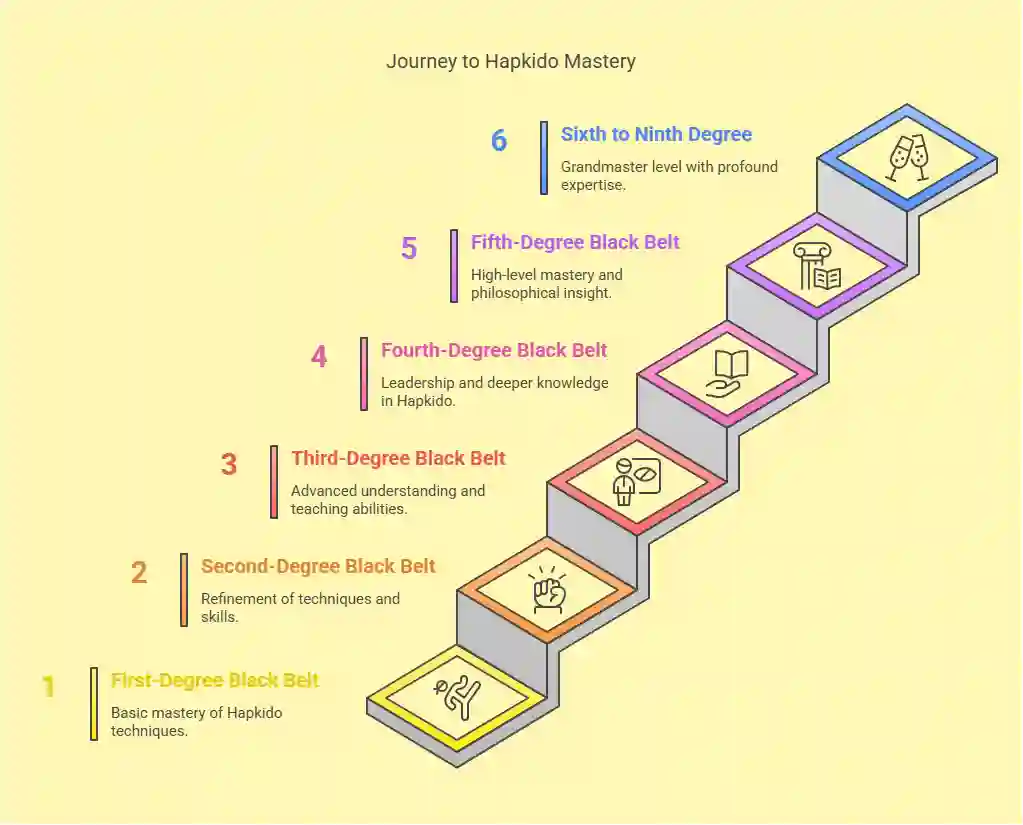
The journey does not end at the black belt. Hapkido has multiple black belt levels.
- First-Degree Black Belt (Dan 1) – Basic mastery of Hapkido.
- Second-Degree Black Belt (Dan 2) – More refined techniques.
- Third-Degree Black Belt (Dan 3) – Advanced understanding and teaching skills.
- Fourth-Degree Black Belt (Dan 4) – Leadership and deeper knowledge.
- Fifth-Degree Black Belt (Dan 5) – High-level mastery and philosophy.
- Sixth to Ninth Degree Black Belt – Reserved for grandmasters.
Each black belt level takes years to earn. Dedication and practice are essential. What’s Next After Black Belt? Click Here!
How Long Does It Take to Advance in the Hapkido Belt Order?
Progress depends on training and dedication. Some students advance quickly. Others take longer. On average:
- White to Yellow Belt: 3–6 months
- Yellow to Green Belt: 6–12 months
- Green to Blue Belt: 1–2 years
- Blue to Brown Belt: 2–3 years
- Brown to Black Belt: 3–5 years
Higher black belt levels take much longer. Some take decades to achieve. Level Up Your Skills with Hapkido!
The Importance of Each Belt in Hapkido

Each belt has a purpose. The hapkido belt order builds a strong foundation. It also helps students grow mentally and physically.
Discipline and Respect
Students learn self-control. They also develop respect for their teachers and peers.
Physical Strength and Flexibility
Each level improves flexibility and strength. The body adapts to new challenges.
Mental Focus
Hapkido requires concentration. Students must think fast and react correctly.
Training Tips for Advancing in Hapkido
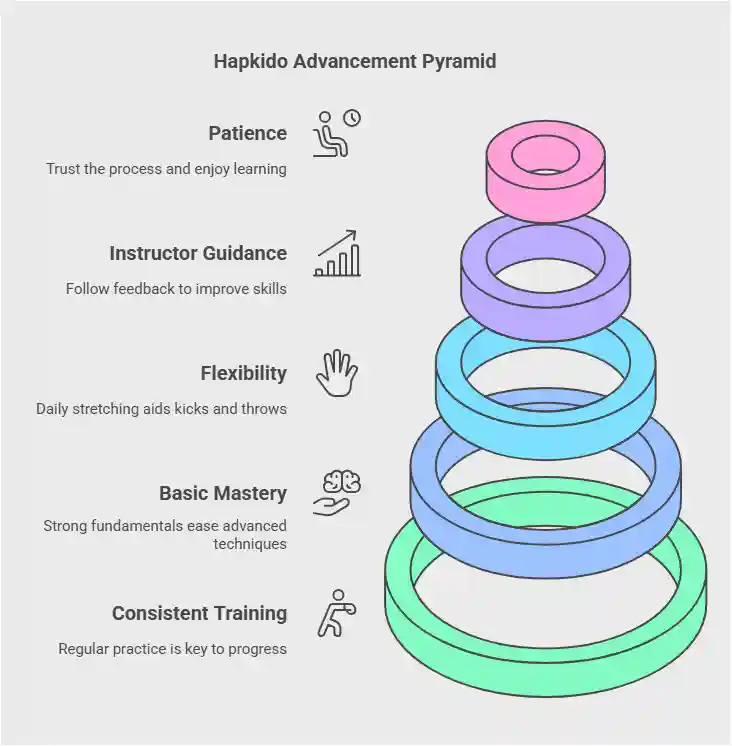
Want to move up in the hapkido belt order? Follow these tips:
Train Consistently
Regular practice is key. Attend classes and train at home.
Master the Basics
Strong fundamentals make advanced techniques easier. Focus on stances, strikes, and blocks.
Improve Flexibility
Stretch daily. Flexibility helps with kicks and throws.
Listen to Your Instructor
Follow the guidance and accept feedback. Instructors help you improve.
Stay Patient
Progress takes time. Trust the process and enjoy learning.
The Role of Sparring in Hapkido
Sparring is important in hapkido. It tests skills in real situations. Level Up Your Skills with Hapkido! The hapkido belt order includes sparring at advanced levels.
- Beginner Sparring – Light contact and basic drills.
- Intermediate Sparring – Controlled strikes and counterattacks.
- Advanced Sparring – Full-contact practice with skilled partners.
Sparring helps students react under pressure. It also builds confidence.
Hapkido vs Other Martial Arts Belt Systems
Hapkido’s belt system is similar to others. Discover the Hapkido Belt System! But there are differences.
Hapkido vs Taekwondo
Hapkido has fewer belt colors. Taekwondo focuses more on high kicks.
Hapkido vs Judo
Judo has fewer belt levels. Hapkido includes more strikes and joint locks.
Hapkido vs Karate
Karate belts follow a similar order. Hapkido includes more throwing techniques.
Each martial art has its strengths. The hapkido belt order focuses on self-defense and control.
Famous Hapkido Masters
Several martial artists helped shape hapkido.
- Choi Yong-Sool – Founder of modern hapkido.
- Ji Han-Jae – Spread hapkido worldwide.
- Myung Jae-Nam – Blended hapkido with aikido.
Their influence helped develop the Hapkido belt order.
Final Thoughts on Hapkido Belt Order
Stepping onto the Hapkido mat for the first time felt like entering a whole new world, full of possibilities. My journey through the Hapkido belt order has been more than just learning moves; it’s been about self-discovery and pushing past my limits. Looking back, I can truly say it’s an experience that shapes you, both physically and mentally.
See the latest Top-Rated Adjustable Dumbbells Set Price Today Used by Champions.

Common Questions About Hapkido Belts Order
No. Each belt must be earned through training.
Progress slows. Consistency is important.
Some schools use different systems for kids. Adults usually follow the standard Hapkido belt order.
Instructors decide based on skill, knowledge, and effort.
Earning a black belt in Hapkido usually takes 3–5 years with consistent training. Progress depends on school, dedication, and skill. Learn more about belt timelines.
Yes, Hapkido teaches real-world self-defense with joint locks, throws, and strikes. It’s designed to handle chaotic situations. Learn more about its street effectiveness.
It’s rare, but possible with intense training, prior experience, and school approval. Most take longer for skill mastery. Learn more about fast-track programs.
The hardest belt to earn depends on the art, but Brazilian Jiu-Jitsu’s black belt is known for strict standards and long timelines. Learn more about belt difficulty levels.

Founder, Owner, and CEO of TaekwondoKing.
He is one of the top 100 martial artists in the World and among the top 20 referees in Bangladesh.
Ehatasamul Alom is an esteemed Kukkiwon Certified Taekwondo 3rd Dan Black Belt with over 15 years of experience in this dynamic martial art. Born in Rajshahi, Bangladesh, Ehatasamul’s journey with Taekwondo began at the tender age of seven. His passion led him to compete at national and international levels, where he has bagged numerous awards and honors. He is also a member of the Taekwondo National Referee Panel.
With a Bachelor’s degree in Sports Science from the prestigious Rajshahi University, Ehatasamul has a deep understanding of the technical and scientific aspects of martial arts and some other martial arts.
In 2022, Ehatasamul created the “TaekwondoKing.com” to share his knowledge, Free Resources, Values, and Real experiences. His articles focus on Taekwondo training techniques, competition strategies, Sport Products Reviews, and the art’s rich history and philosophy. He also writes about the importance of mental fortitude and discipline, key aspects of his teaching philosophy. He has already launched many sports, Taekwondo, and health-related Free online tools. His goal is to inspire both beginners and seasoned practitioners worldwide through insightful and engaging content.
If you need any help, contact Ehatasamul Alom at any time.

